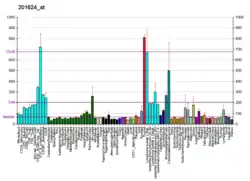DARS (gene)
Aspartyl-tRNA synthetase, cytoplasmic is an enzyme that in humans is encoded by the DARS gene.[5][6]
| DARS1 | |||||||||||||||||||||||||||||||||||||||||||||||||||
|---|---|---|---|---|---|---|---|---|---|---|---|---|---|---|---|---|---|---|---|---|---|---|---|---|---|---|---|---|---|---|---|---|---|---|---|---|---|---|---|---|---|---|---|---|---|---|---|---|---|---|---|
| |||||||||||||||||||||||||||||||||||||||||||||||||||
| Identifiers | |||||||||||||||||||||||||||||||||||||||||||||||||||
| Aliases | DARS1, HBSL, aspRS, aspartyl-tRNA synthetase, aspartyl-tRNA synthetase 1, DARS | ||||||||||||||||||||||||||||||||||||||||||||||||||
| External IDs | OMIM: 603084 MGI: 2442544 HomoloGene: 1032 GeneCards: DARS1 | ||||||||||||||||||||||||||||||||||||||||||||||||||
| |||||||||||||||||||||||||||||||||||||||||||||||||||
| |||||||||||||||||||||||||||||||||||||||||||||||||||
| |||||||||||||||||||||||||||||||||||||||||||||||||||
| |||||||||||||||||||||||||||||||||||||||||||||||||||
| |||||||||||||||||||||||||||||||||||||||||||||||||||
| Wikidata | |||||||||||||||||||||||||||||||||||||||||||||||||||
| |||||||||||||||||||||||||||||||||||||||||||||||||||
Aspartyl-tRNA synthetase (DARS) is part of a multienzyme complex of aminoacyl-tRNA synthetases. Aspartyl-tRNA synthetase charges its cognate tRNA with aspartate during protein biosynthesis.[6]
Clinical significance
Mutations in DARS have been identified as the cause of leukoencephalopathy, hypomyelination with brain stem and spinal cord involvement and leg spasticity (HBSL).[7]
See also
References
- GRCh38: Ensembl release 89: ENSG00000115866 - Ensembl, May 2017
- GRCm38: Ensembl release 89: ENSMUSG00000026356 - Ensembl, May 2017
- "Human PubMed Reference:". National Center for Biotechnology Information, U.S. National Library of Medicine.
- "Mouse PubMed Reference:". National Center for Biotechnology Information, U.S. National Library of Medicine.
- Jacobo-Molina A, Peterson R, Yang DC (Oct 1989). "cDNA sequence, predicted primary structure, and evolving amphiphilic helix of human aspartyl-tRNA synthetase". J Biol Chem. 264 (28): 16608–12. doi:10.1016/S0021-9258(19)84749-X. PMID 2674137.
- "Entrez Gene: DARS aspartyl-tRNA synthetase".
- Taft RJ, Vanderver A, Leventer RJ, Damiani SA, Simons C, Grimmond SM, Miller D, Schmidt J, Lockhart PJ, Pope K, Ru K, Crawford J, Rosser T, de Coo IF, Juneja M, Verma IC, Prabhakar P, Blaser S, Raiman J, Pouwels PJ, Bevova MR, Abbink TE, van der Knaap MS, Wolf NI (2013). "Mutations in DARS cause hypomyelination with brain stem and spinal cord involvement and leg spasticity". American Journal of Human Genetics. 92 (5): 774–780. doi:10.1016/j.ajhg.2013.04.006. PMC 3644624. PMID 23643384.
Further reading
- Norcum MT (1991). "Structural analysis of the high molecular mass aminoacyl-tRNA synthetase complex. Effects of neutral salts and detergents". J. Biol. Chem. 266 (23): 15398–405. doi:10.1016/S0021-9258(18)98629-1. PMID 1651330.
- Reed VS, Wastney ME, Yang DC (1995). "Mechanisms of the transfer of aminoacyl-tRNA from aminoacyl-tRNA synthetase to the elongation factor 1 alpha". J. Biol. Chem. 269 (52): 32932–6. doi:10.1016/S0021-9258(20)30080-6. PMID 7806521.
- Maruyama K, Sugano S (1994). "Oligo-capping: a simple method to replace the cap structure of eukaryotic mRNAs with oligoribonucleotides". Gene. 138 (1–2): 171–4. doi:10.1016/0378-1119(94)90802-8. PMID 8125298.
- Escalante C, Yang DC (1993). "Expression of human aspartyl-tRNA synthetase in Escherichia coli. Functional analysis of the N-terminal putative amphiphilic helix". J. Biol. Chem. 268 (8): 6014–23. doi:10.1016/S0021-9258(18)53420-7. PMID 8449960.
- Suzuki Y, Yoshitomo-Nakagawa K, Maruyama K, et al. (1997). "Construction and characterization of a full length-enriched and a 5'-end-enriched cDNA library". Gene. 200 (1–2): 149–56. doi:10.1016/S0378-1119(97)00411-3. PMID 9373149.
- Quevillon S, Robinson JC, Berthonneau E, et al. (1999). "Macromolecular assemblage of aminoacyl-tRNA synthetases: identification of protein-protein interactions and characterization of a core protein". J. Mol. Biol. 285 (1): 183–95. doi:10.1006/jmbi.1998.2316. PMID 9878398.
- Rho SB, Kim MJ, Lee JS, et al. (1999). "Genetic dissection of protein-protein interactions in multi-tRNA synthetase complex". Proc. Natl. Acad. Sci. U.S.A. 96 (8): 4488–93. Bibcode:1999PNAS...96.4488R. doi:10.1073/pnas.96.8.4488. PMC 16359. PMID 10200289.
- Kang J, Kim T, Ko YG, et al. (2000). "Heat shock protein 90 mediates protein-protein interactions between human aminoacyl-tRNA synthetases". J. Biol. Chem. 275 (41): 31682–8. doi:10.1074/jbc.M909965199. PMID 10913161.
- Sang Lee J, Gyu Park S, Park H, et al. (2002). "Interaction network of human aminoacyl-tRNA synthetases and subunits of elongation factor 1 complex". Biochem. Biophys. Res. Commun. 291 (1): 158–64. doi:10.1006/bbrc.2002.6398. PMID 11829477.
- Strausberg RL, Feingold EA, Grouse LH, et al. (2003). "Generation and initial analysis of more than 15,000 full-length human and mouse cDNA sequences". Proc. Natl. Acad. Sci. U.S.A. 99 (26): 16899–903. Bibcode:2002PNAS...9916899M. doi:10.1073/pnas.242603899. PMC 139241. PMID 12477932.
- Cheong HK, Park JY, Kim EH, et al. (2004). "Structure of the N-terminal extension of human aspartyl-tRNA synthetase: implications for its biological function". Int. J. Biochem. Cell Biol. 35 (11): 1548–57. doi:10.1016/S1357-2725(03)00070-0. PMID 12824064.
- Bouwmeester T, Bauch A, Ruffner H, et al. (2004). "A physical and functional map of the human TNF-alpha/NF-kappa B signal transduction pathway". Nat. Cell Biol. 6 (2): 97–105. doi:10.1038/ncb1086. PMID 14743216. S2CID 11683986.
- Gerhard DS, Wagner L, Feingold EA, et al. (2004). "The status, quality, and expansion of the NIH full-length cDNA project: the Mammalian Gene Collection (MGC)". Genome Res. 14 (10B): 2121–7. doi:10.1101/gr.2596504. PMC 528928. PMID 15489334.
- Bonnefond L, Fender A, Rudinger-Thirion J, et al. (2005). "Toward the full set of human mitochondrial aminoacyl-tRNA synthetases: characterization of AspRS and TyrRS". Biochemistry. 44 (12): 4805–16. doi:10.1021/bi047527z. PMID 15779907.
- Rual JF, Venkatesan K, Hao T, et al. (2005). "Towards a proteome-scale map of the human protein-protein interaction network". Nature. 437 (7062): 1173–8. Bibcode:2005Natur.437.1173R. doi:10.1038/nature04209. PMID 16189514. S2CID 4427026.
- Tu LC, Yan X, Hood L, Lin B (2007). "Proteomics analysis of the interactome of N-myc downstream regulated gene 1 and its interactions with the androgen response program in prostate cancer cells". Mol. Cell. Proteomics. 6 (4): 575–88. doi:10.1074/mcp.M600249-MCP200. PMID 17220478.
This article is issued from Wikipedia. The text is licensed under Creative Commons - Attribution - Sharealike. Additional terms may apply for the media files.





